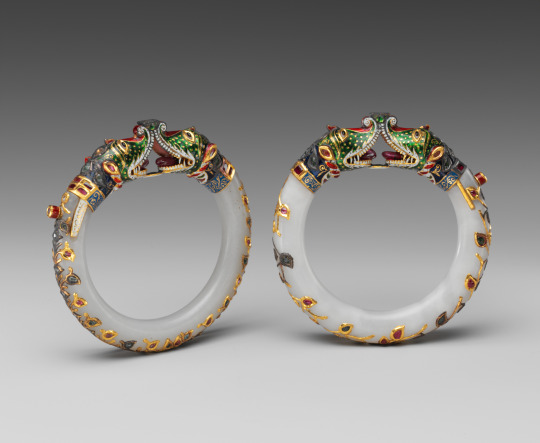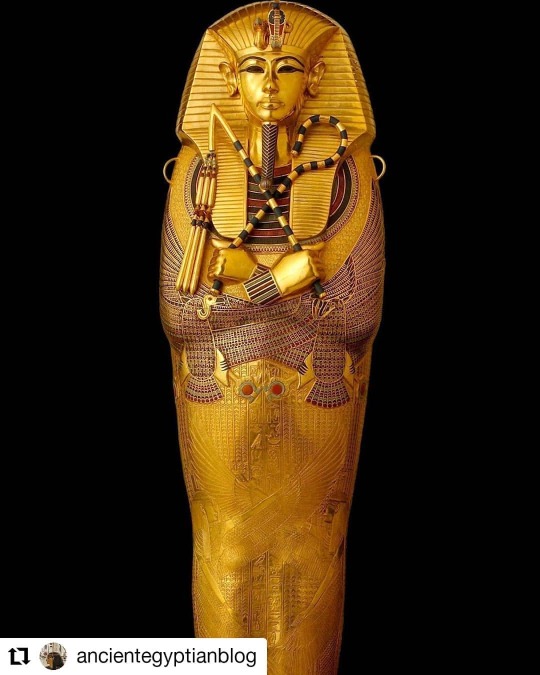#gold with inlay of enamel and semiprecious stones
Text
Tutankhamun’s sarcophagus (a box-like stone container) held not one but three coffins in which to hold the body of the king. The outer two coffins were crafted in wood and covered in gold along with many semiprecious stones, such as lapis lazuli and turquoise.Tutankhamun’s tomb, innermost coffin, New Kingdom, 18th Dynasty, c. 1323 B.C.E., gold with inlay of enamel and semiprecious stones (Egyptian Museum, Cairo)
The inner coffin, however, was made of solid gold. When Howard Carter first came upon this coffin, it was not the shiny golden image we see in the Egyptian Museum today
#iregipto #egyptpassion #mbplanet #history #historic #luxor #Egypt #egiptologia #egipto #guia #kingtut #kingtutankamon #tomb #sarcophagus
86 notes
·
View notes
Text

Bracelet (one of a pair). India (Mughal). 18th-19th Century.
Jade (nephrite), Gold, Enamel, and Semiprecious Stone Inlays
from the Metropolitan Museum of Art
#my mutuals know I love a pair of bracelets#also if no one has noticed I love posting historical jewelry pieces a lot#mughal empire#mughal artifacts#history#historical artifacts#mughal
17 notes
·
View notes
Text
23. Tutankhamun's tomb, innermost coffin

Found in Egypt
New Kingdom, 18th Dynasty
Created c. 1323 BCE
Gold with inlay of enamel and semiprecious stones
2 notes
·
View notes
Text

Bracelets. India (Mughal). 18th-19th century. Made of jade (nephrite) with gold, enamel, and semiprecious stone inlays.
via The Metropolitan Museum of Art
0 notes
Text

The Death Mask of Tutankhamun from innermost coffin
Tutankhamun’s tomb, New Kingdom, 18th Dynasty, c. 1323 B.C.
gold with inlay of enamel and semiprecious stones
Egyptian Museum, Cairo
photo: Bjørn Christian Tørrissen, CC BY-SA 3.0
#The Death Mask of Tutankhamun from innermost coffin#The Death Mask of Tutankhamun#Egypt#King#burial#Tutankhamun’s tomb New Kingdom 18th Dynasty c. 1323 B.C.#gold with inlay of enamel and semiprecious stones#Egyptian Museum Cairo#history#photo: Bjørn Christian Tørrissen CC BY-SA 3.0
165 notes
·
View notes
Text
Prehistoric Art (11 Works)
The discipline of art history examines art and the practices of art making, and explores how theories and interpretations of art develop and change over time. Cultural practices, belief systems, and physical setting are important parts of understanding art and art making. The influence of these factors can be seen in early works from throughout the world that share certain features, including a concern with the natural world and humans’ place within it.
Cultural Influences on Prehistoric Art
Materials, Processes, and Techniques in Prehistoric Art
Theories and Interpretations of Prehistoric Art
Apollo 11 stones. Namibia. C. 25,000–25,300 BCE. Charcoal on stone.
Great Hall of the Bulls. Lascaux, France (Paleolithic Europe). 15,000–13,000 BCE. Rock painting.
Camelid sacrum in the shape of a canine. Texquixquiac, Central Mexico. 14,000–7000 BCE. Bone.
Running Horned Woman. Tassili n'Ajjer, Algeria. 6000–4000 BCE. Pigment on rock.
Beaker with ibex motifs. Susa, iran. 4200–3500 BCE. Painted terra cotta.
Anthropomorphic stele. Arabian Peninsula. Fourth millennium BCE. Sandstone.
Jade cong. Liangzhu, China. 3300–2200 BCE. Carved jade.
Stonehenge. Wiltshire, Uk (Neolithic Europe). c. 2500–1600 BCE. Sandstone.
The Ambum stone. Ambum Valley, Enga Pronvince, Papua New Guinea. c. 1500 BCE. Greywacke.
Tlatlico female figurine. Central Mexico, site of Tlatlico. 1200–900 BCE. Ceramic.
Terra cotta Fragment. Reef Islands, Solomon Islands. 1000 BCE. Terra cotta (incised).
⠀
Ancient Near East Art (6 Works)
White Temple and its ziggurat. Uruk (modern Warka, Iraq). Sumerian. c. 3500–3000 BCE. 40ft. Mud brick.
Statues of votive figures. Square Temple at Eshnunna (modern Tell Asmar, Iraq). Sumerian. c. 2700 BCE. Gypsum inlaid with shell and black limestone.
Standard of Ur. Royal Tombs at Ur (modern Tell el-Muqayyer, Iraq). Sumerian. c. 2600–2400 BCE. Wood inlaid with shell, lapis lazuli, and red limestone.
The Code of Hammurabi. Babylon (modern Iran). Babylonian. c. 1792–1750 BCE. 7ft 3in. Basalt.
Lamassu from the citadel of Sargon II. Dur Sharrukin (Khorsabad, Iraq). Assyrian. c. 720–705 BCE. 10.5ft. Alabaster.
Audience Hall (apadana) of Darius and Xerxes. Persepolis, Iran. Persian. c. 520–465 BCE. 42ft. Limestone.
⠀
Egyptian Art (9 Works)
Background
Palette of King Narmar. Predynastic Egypt. c. 3000–2920 BCE. 25in. Greywacke.
Seated scribe. Saqqara Egypt. (Old Kingdom, Fourth Dynasty) c. 2620–2500 BCE. 21x17x14in. Painted limestone.
Great Pyramids (Menkaura, Khafre, Khufu) and Great Sphinx. Giza, Egypt. (Old Kingdom, Fourth Dynasty) c. 2550–2490 BCE. Cut limestone.
King Menkaura and queen. (Old Kingdom, Fourth Dynasty) c. 2490–2472 BCE. Greywacke.
Temple of Amun-Re and Hypostle Hall. Kamak, near Luxor, Egypt (New Kingdom) Temple: c. 1550 BCE, Hall: c. 1250. Cut sandstone and mud brick.
Mortuary temple of Hatshepsut. Near Luxor, Egypt. (New Kingdom) c. 1473–1458 BCE. Sandstone, partially carved into a rock cliff, and red granite.
Akhenaten, Nefertiti, and three daughters. (New Kingdom, 18th Dynasty). c. 1353–1335 BCE. Limestone.
Tutankhamun's tomb, innermost coffin. (New Kingdom, 18th Dynasty). c. 1323 BCE. Gold with inlay of enamel and semiprecious stones.
Last judgement of Hunefer. Hunefer's tomb. (New Kingdom, 19th Dynasty). c. 1275 BCE. Painted papyrus scroll.
⠀
Greek Art (11 Works)
Background
Athenian agora. (Archaic through Hellenistic Greek) 600 BCE–150 CE. Plan.
Anavysos Kuoros. (Archaic Greek) c. 530 BCE. Marble with remnants of paint.
Peplos Kore from the Acropolis. (Archaic Greek) c. 530 BCE. Marble, painted details.
Niobides Krater. Anonymous vase painter known as Niobid Painter. (Classical Greek) c. 460–450 BCE. Clay, red-figure technique (white highlights).
Doryphoros (Spear Bearer). Polykleitos. (Original) 450–440 BCE. Roman copy (marble) of Greek original (bronze)
Acropolis. Athens, Greece. Iktinos and Kallikrates. c. 447–410 BCE. Marble.
Grave stele of Hegeso. Attributed to Kallimachos. c. 410 BCE. Marble and paint.
Winged Victory of Samothrace. (Hellenistic Greek) c. 190 BCE. Marble.
Great Altar of Zeus and Athena. Pergamom, Asia Minor (present-day Turkey), Hellenistic Greek. c. 175 BCE. Marble (architecture and sculpture).
Alexander Mosaic. House of Faun, Pompeii. Republican Roman. c. 100 BCE. Mosaic.
Seated boxer. Hellenistic Greek. c. 100 BCE. Bronze.
⠀
Roman Art (7 Works)
Background
House of the Vettii. Pompeii, Italy. Imperial Roman. c. second century BCE; rebuilt, c. 62–79 CE. Cut stone and fresco.
Head of a Roman patrician. Republican Roman. c. 75–50 BCE. Marble.
Augustus of Prima Porta. Imperial Roman. Early first century Ce. Marble.
Colosseum (Flavian Aphitheater). Rome, Italy. Imperial Roman. 70–80 CE. Stone and concrete.
Forum of Trajan. Rome, Italy. Apollodorus of Damascus. Forum and markets: 106–112 CE; column completed 113 CE. Brick and concrete (architecture); marble (column).
Pantheon. Imperial Roman. 118–125 CE. Conrete with stone facing.
Ludovisi Battle Sarcophagus.. Late Imperial Roman. c. 250 CE. Marble
⠀
Etruscan (3 Works)
Background
Sarcophagus of the Spouses. Etruscan. c. 520 BCE. Terra cotta.
Temple of Minerva and sculpture of Apollo. Veii (near Rome, Italy). Master sculptor Vulca. c. 510–500 BCE. Original temple of wood, mud cbrick, or tufa (volcanic rock); terra cotta sculpture.
Tomb of the Triclinium. Tarquinia, Italy. Etruscan. c. 480–470 BCE. Tufa and fresco.
⠀
Byzantine Art
Background
Catacomb of Priscilla. Rome, Italy. (Late Antique Europe) c. 200–400 CE. Excavated tufa and fresco.
Santa Sabina. Rome, Italy. (Late Antique Europe) c. 422–432 CE. Brick and stone, wooden roof.
Rebecca and Eliezer at the Well and Jacob Wrestling the Angel, from Vienna Genesis. Early Byzantine Europe. Early 6th century CE. Illuminated maniscrupt (tempera, gold, and silver on purple vellum).
San Vitale. Ravenna, Italy (Early Byzantine Europe). c. 526–547 CE. Brick, marble, and stone veneer; mosaic.
Hagia Sophia. Constantinople (Istanbul). Anthemius of Tralles and Isidorus of Miletus. 532–537 CE. Brick and ceramic elements with stone and mosaic veneer.
Merovingian looped fibulae. Early medieval Europe. Mid-sixth century CE. Silver gilt worked in filigree, with inlays of garnets and other stones.
Virgin (Theotokos) and Child between Saints Theodore and George. Early Byzantine Europe. Sixth or early seventh century CE. Encaustic on wood.
0 notes
Photo

#Repost @ancientegyptianblog • • • • • • Egyptian Museum The solid gold coffin of Pharaoh Tutankhamun. Tutankhamun’s tomb, innermost coffin - gold with inlay of enamel and semiprecious stones. The innermost coffin was certainly a spectacle to behold. When the lid of the second sarcophagus was finally lifted, it revealed a human image much like the first two, however, this one was made from solid gold. In 1929, the sarcophagus was weighed at 110.4 kgs (243.39 lbs.), thus its scrap value at that time would have been 1.7 million USD. As in the first two coffins, the image of the king lays with his arms crossed holding the crook and flail. However, the inlaid materials are much more rich on this coffin. The eyes are inlays of calcite and obsidian, the eyebrows and cosmetic lines are lapis-lazuli coloured glass. At the neck of the coffin were placed two heavy necklaces of disc beads made of red, yellow, and blue faience. Underneath the hands of the king, the goddesses Nekhbet and Wadjet, made from gold sheet and inlaid red-backed quartz along with lapis and turquoise coloured glass, spread their wings protectively around the upper body of the king. In their talons they each grasp the Egyptian Hieroglyph for “infinity.” The goddesses Isis and Nephthys are also present again on the rishi background, much like in the two previous coffins. Like the outermost coffin, the innermost was fitted with four handles which made the lid easier to remove. Thus, at long last, “The lid was raised by its golden handles and the mummy of the king disclosed.” #ancientegypt #ancientegyptianblog #egypt #kemet #egittologia #madeinegypt #egyptianart #worldart #civilization #tutankhamun #archeology #egyptology #egyptian #antiguoegipto #iloveegypt #visitegypt #ancientegyptian #ancientegyptiancivilization #hieroglyphs #egiptian #egipt #ancient #ancienthistory #ancientkemet #ancient #ancientegyptians #loveegypt #egyptianmuseum #Royalty #kingtut #tutankhamon https://www.instagram.com/p/B_1wWbGBbBn/?igshid=sgod9fmscjgk
#repost#ancientegypt#ancientegyptianblog#egypt#kemet#egittologia#madeinegypt#egyptianart#worldart#civilization#tutankhamun#archeology#egyptology#egyptian#antiguoegipto#iloveegypt#visitegypt#ancientegyptian#ancientegyptiancivilization#hieroglyphs#egiptian#egipt#ancient#ancienthistory#ancientkemet#ancientegyptians#loveegypt#egyptianmuseum#royalty#kingtut
0 notes
Text

Tutankhamun’s tomb, innermost coffin
New Kingdom, 18th Dynasty
c. 1323 B.C.
gold with inlay of enamel and semiprecious stones
(Egyptian Museum, Cairo)
2 notes
·
View notes